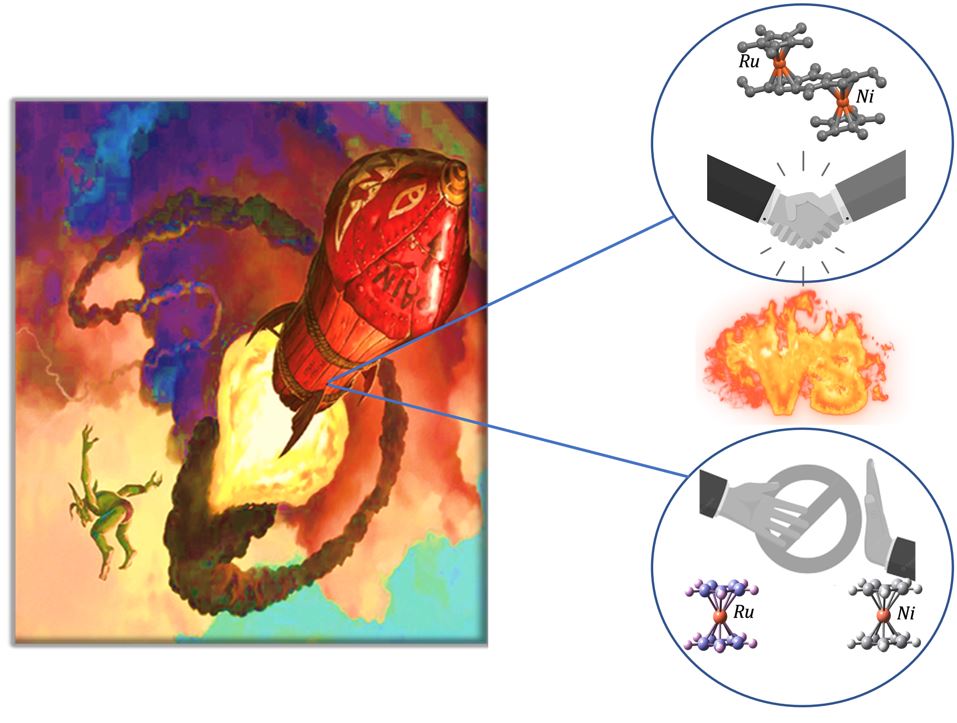INSIGHTS FROM DIFFERENTIAL SCANNING CALORIMETRY AND CYCLIC VOLTAMMETRY ANALYSES: STUDIES OF THE SYNERGISTIC EFFECT OF TWO DIFFERENT METALLOCENES ON THE MAIN OXIDIZING AGENT FOR SOLID ROCKET MOTOR

- Thermal decomposition,
- Burning Rate Catalysis,
- Composite Solid Propellant,
- cyclic voltammetry
Copyright (c) 2023 SChQ

This work is licensed under a Creative Commons Attribution-NonCommercial-ShareAlike 4.0 International License.
Abstract
ABSTRACT:
To understand the synergistic catalytic effect on the thermal degradation of Ammonium Perchlorate (AP) when the metal fragments are in the same molecule or not, we compared three reported compounds: [(Cp*)2Ni] (1), [(Cp*)2Ru] (2), and [Cp*Ni-s-Ic’-RuCp*] (3), as potential burning rate catalysts. We conducted a differential scanning calorimetry (DSC) analysis of compound (3), which showed an increase in the high-temperature decomposition (HTD) of AP to 418 ºC and a decrease in the energy release to 938 J·g-1. These results were compared to those of the different metallocenes, namely (1) (HTD: 434 ºC and 1300 J·g-1), (2) (HTD: 361 ºC and 1828 J·g-1), and the mixture of (1+2) (HTD: 354 ºC and 2054 J·g-1). Our results suggest that the mixture of metallocenes is a suitable and competitive alternative to be used as an enhancer of solid composite propellants. In addition, cyclic voltammetry is used to investigate the electrochemical processes of compounds (1), (2), and (3). The electrochemically active species exhibit noteworthy oxidation peaks, revealing electronic communication between the three different compounds in the cases of (1), (2), and (3), as evidenced by the results obtained from the analysis.
References
- J. Gaete, J.L. Arroyo, A. Norambuena, G. Abarca, C. Morales-verdejo, Mechanistic Insights into the Thermal Decomposition of Ammonium Perchlorate : The Role of Amino-Functionalized Magnetic Nanoparticles, Inorg. Chem. 61 (2022) 1447–1455. doi:10.1021/acs.inorgchem.1c03121.
- J. Gaete, C. Valdebenito, Y. Dibdalli, J.L. Arroyo, Á. Norambuena, F. Valenzuela, C. Basualto, G. Abarca, C. Morales-Verdejo, Superparamagnetic energetic nanoparticles : a surface self ‑ propagation pathway for the thermal decomposition of ammonium perchlorate, J. Therm. Anal. Calorim. (2023). doi:10.1007/s10973-022-11885-5.
- L. Jiang, M. Liu, L. Xu, T. Dong, J. Li, G. Zhang, Synthesis and Characterization of a Dinuclear Nitrogen-Rich Ferrocenyl Ligand and Its Ionic Coordination Compounds and Their Catalytic Effects During Combustion, ZAAC ‐ J. Inorg. Gen. Chem. 645 (2019) 92–100. doi:10.1002/zaac.201800417.
- M. Usman, L. Wang, H. Yu, F. Haq, R. Liang, R. Summe Ullah, A. Khan, A. Nazir, T. Elshaarani, K. Naveed, Inorganica Chimica Acta Synthesis , anti-migration properties and burning rate catalytic properties of ferrocene-based compounds, Inorganica Chim. Acta. 495 (2019) 118958. doi:10.1016/j.ica.2019.118958.
- M. Usman, H. Yu, L. Wang, P.A. Zhizhko, D.A. Lemenovskiy, D.N. Zarubin, A. Khan, K. Naveed, Synthesis of ferrocenylated-aminopyridines and ferrocenylated- aminothiazoles and their anti-migration and burning rate catalytic properties, J. Organomet. Chem. 920 (2020) 121336. doi:10.1016/j.jorganchem.2020.121336.
- J.L. Arroyo, A. Norambuena, H. Reyes, C. Valdebenito, G. Abarca, D.M. Carey, C. Morales-verdejo, Heterobimetallic Catalysts for the Thermal Decomposition of Ammonium Perchlorate : Efficient Burning Rate Catalysts for Solid Rocket Motors and Missiles, Inorg. Chem. 60 (2021) 1436–1448. doi:10.1021/acs.inorgchem.0c02639.
- K. Ghosh, S. Behera, A. Kumar, B.G. Padale, D.G. Deshpande, A. Kumar, M. Gupta, Studies on aluminized, high burning rate, Butacene® based, composite propellants, Cent. Eur. J. Energ. Mater. 11 (2014) 323–334.
- Á. Norambuena, P. Gutiérrez, J.L. Arroyo, H. Reyes, C. Morales-verdejo, Studies of burning rate and pressure exponent of a new combustion catalyst derived from p-phenylene, J. Energ. Mater. (2021). doi:10.1080/07370652.2021.1942329.
- S. Chaturvedi, P.N. Dave, Solid propellants : AP/HTPB composite propellants, Arab. J. Chem. 12 (2019) 2061–2068. doi:10.1016/j.arabjc.2014.12.033.
- M.E. Smith, Synthesis, Characterization, and Reactivity of Pentamethylcyclopentadienyl Complexes of Divalent Cobalt and Nickel, 1993. https://escholarship.org/uc/item/0vg5n9kq#author.
- S. Trupia, A. Nafady, W.E. Geiger, Electrochemical Preparation of the Bis(ruthenocenium) Dication, Inorg. Chem. 42 (2003) 5480–5482. doi:10.1021/ic030146+.
- C. Morales-Verdejo, I. Martinez, D. Mac-Leod Carey, I. Chavez, J.M. Manríquez, D. Matioszek, N. Saffon, A. Castel, P. Rivière, E. Molins, Synthesis and structure of some heterobimetallic complexes having a polyalkyl-s-indacenyl spacer, Inorganica Chim. Acta. 394 (2013). doi:10.1016/j.ica.2012.09.040.
- C. Morales-Verdejo, M.B. Camarada, J.L. Arroyo, P. Povea, G. Carreño, J.M. Manriquez, Effect of the homo- and heterobimetallic compounds derived from s-indacene on the thermal decomposition of ammonium perchlorate: Potential applications as burning rate catalysts, J. Therm. Anal. Calorim. 131 (2018) 353–361. doi:10.1007/s10973-017-6534-7.
- J.L. Arroyo, P. Povea, R. Faúndez, M.B. Camarada, C. Cerda-cavieres, G. Abarca, J.M. Manriquez, C. Morales-Verdejo, Influence iron-iron distance on the thermal decomposition of ammonium perchlorate . New catalysts for the highly efficient combustion of solid rocket propellant, J. Organomet. Chem. 905 (2020) 121020. doi:10.1016/j.jorganchem.2019.121020.
- P. Aguirre-Etcheverry, D. O’Hare, Electronic communication through unsaturated hydrocarbon bridges in homobimetallic organometallic complexes, Chem. Rev. 110 (2010) 4839–4864. doi:10.1021/cr9003852.
- B.U. Amin, H. Yu, L. Wang, A. Nazir, S. Fahad, F. Haq, S. Mahmood, R. Liang, A. Uddin, T. Lin, Recent advances on ferrocene-based compounds and polymers as a burning rate catalysts for propellants, J. Organomet. Chem. 921 (2020) 121368. doi:10.1016/j.jorganchem.2020.121368.
- Y. Dibdalli, C. Osorio-gutierrez, J.L. Arroyo, M.K. Amshumali, G. Abarca, C. Morales-Verdejo, Catalytic Effects of Ruthenocene Bimetallic Compounds Derived from Fused Aromatic Ring Ligands on the Main Oxidizing Agent for Solid Rocket Motor, J. Braz. Chem. Soc. 33 (2022) 491–497. doi:10.21577/0103-5053.20210168.
- Y. Dibdalli, J. Gaete, C. Valdebenito, J. Luis, I. Martínez, G. Abarca, C. Morales-verdejo, Bimetallic ruthenium compound derived from 6 , 12-dihydroindeno [1 ,2-b ] fluorene ligand as burning rate catalyst for solid rocket motor propellant, J. Organomet. Chem. 973–974 (2022) 122408. doi:10.1016/j.jorganchem.2022.122408.
- D. MacLeod Carey, C. Adams, A. Muñoz-Castro, C. Morales-Verdejo, J.F. Araneda, I. Chavez, J.M. Manríquez, A. Castel, P. Rivière, M. Rivière-Baudet, D. Matioszek, R. Septelean, I. Martinez, R. Arratia-Pérez, A new method to radical anions derived from s-Indacene organobimetallic complexes, their ESR characterization, Inorganica Chim. Acta. 392 (2012). doi:10.1016/j.ica.2012.05.033.
- P.W. Jolly, Comprehensive Organometallic Chemistry, Elsevier, 1982. doi:10.1016/B978-008046518-0.00073-8.


